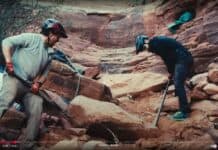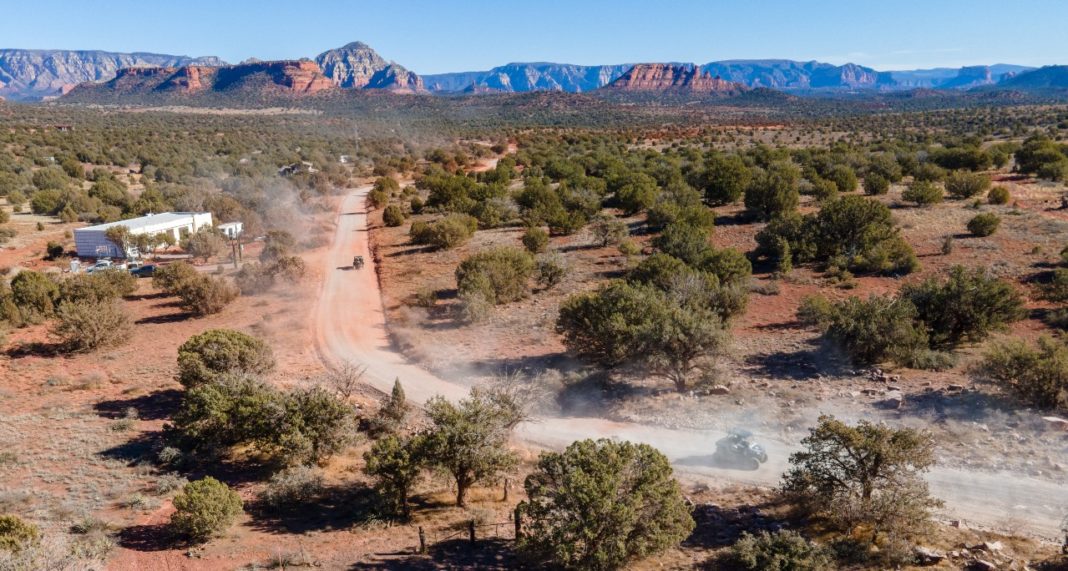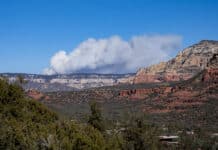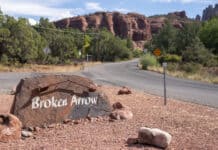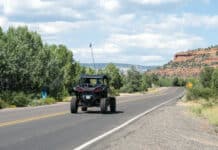This is the second installment in a two-part series on the impact of Utility Terrain Vehicles [UTVs] in the foothills of the Red Rock-Secret Mountain Wilderness west of Sedona. Read the first part here.
When a particularly flagrant UTV or RV incident occurs west of Sedona, a residents’ group emails a list of over 60 officials, which includes Coconino National Forest personnel from Forest Supervisor Laura Jo West on down to the recreation personnel out in the field.
The digital cries for help also go to leaders at the city of Sedona, Yavapai County, and federal and state legislators.
“I am sitting in my truck now on the [Forest Road] 525 just watching the destruction happen before my eyes. I have so much more to add, but I know you all have heard it all. But we will keep putting it out there until it is manageable or until we loose our homes from an unattended fire,” resident Cathy Garner wrote on April 7.
It’s no secret to USFS, Arizona Game & Fish Department, the city of Sedona and others that motorized recreation has dramatically escalated on the soft desert soils west of Sedona, and that it’s impacting the plants and degrading the experience of the area for residents and other recreationists.
So far, no governments or agencies have made any dramatic moves to calm the “crazy” vehicle noise and dust that is choking the forest roads, and reportedly hurting traditional commercial activities like ranching.
A common complaint from agencies is a lack of money and employees to respond. They also believe current laws hamstring them from acting more aggressively to curtail illegal and reckless driving. An underlying issue is that the rising tide of motorized recreation west of Sedona provides little additional revenue to land and wildlife managers to help manage it.
Recently, a working group of stakeholders — including UTV rental companies, ranchers and an aide to U.S. Rep. Tom O’Halleran [D-District 1] — has been video conferencing to talk about the problem.
Rancher Becki Ross and resident DeAnna Bindley credit Yavapai County District 3 Supervisor Donna Michaels with helping to organize the video calls. But so far, no clear solutions have emerged to the tricky problem. Below is a rundown of how key governments and agencies have responded.
USFS
The 550,000-acre Red Rock Ranger District of Coconino National Forest has two law enforcement officers serving an area about two-thirds the size of Yosemite National Park — which is one more LEO than most districts have, District Ranger Amy Tinderholt said. Local outfitter-guide fees paid by Jeep and other tours help fund the district’s second officer. A USA Today report in 2019 found that declining law enforcement personnel on public lands is a national problem, with the number of park rangers declining over the last 10 years even as visitation has increased.
With the Red Rock Ranger District’s two LEOs spread so thin, it’s hard for it to increase enforcement of speeding and off-road driving violations.
As Red Rock Ranger District LEO Mike O’Neil noted, each weekend may bring an entirely new set of visitors, dulling the impact of one weekend of citations.
But that doesn’t mean law enforcement isn’t trying.
“I think everybody’s probably been spending a little bit more time in these areas than they have in the past, [but] it continues to be spreading the availability of very few folks around,” Tinderholt said.
One concrete action the USFS has taken in response to the complaints is to initiate a Road Use Study, which Tinderholt expects to be completed in May or June. The study won’t do anything about traffic volume, but it could result in modifications to make the road safer at its current level of usage.
“The use on this road compared to when it was built is very, very different,” Tinderholt said.
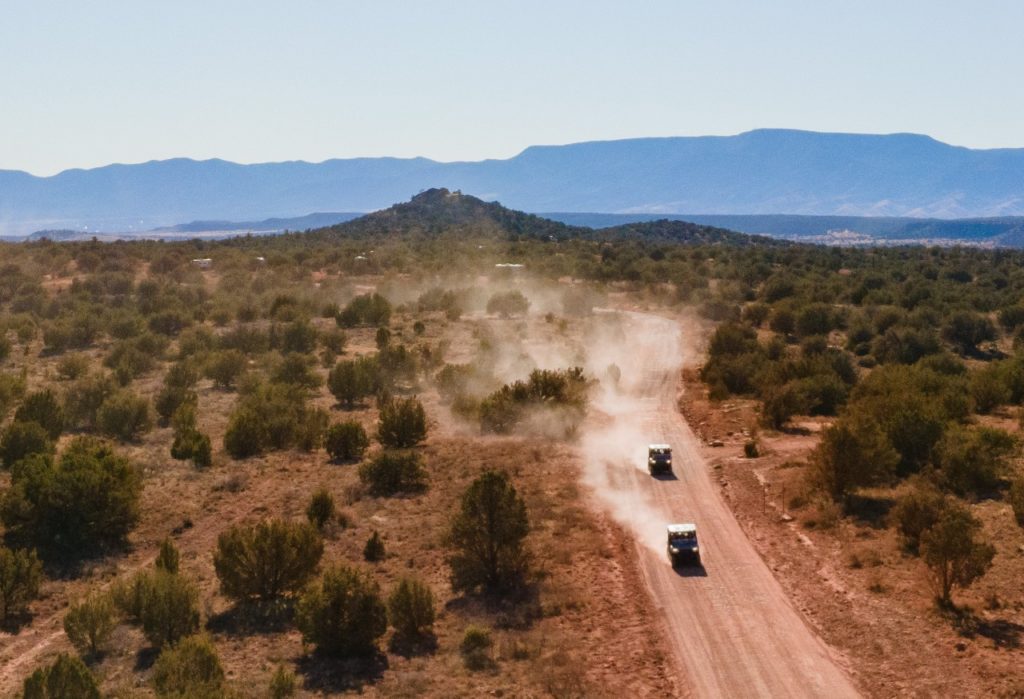
She said the district is also thinking about ways to disperse traffic using alternate routes. Right now, she said, all of the OHV traffic from Sedona must use one or two arteries to access all the trails and destinations in the area.
A portion of machines on the forest roads are rented from companies in Sedona. Tinderholt doesn’t believe USFS has jurisdiction to regulate or collect fees from the rental companies under an outfitter/guide program, as they do with guided Jeep tours. Outfitter/guide manager Julie Rowe said in 2019 that guided tours — primarily Jeep tours — brought in $1 million for the district. Self-guided OHV tour companies have offered voluntary trail maintenance assistance, but no funds go to the district from this industry.
Arizona Game & Fish
In 1991, the Arizona State Legislature created an off-highway vehicle recreation fund, funded by $25 OHV decals which both in-state and out-of-state OHV drivers must purchase to drive on roads and trails in Arizona, and 0.55% of the motor vehicle fuel tax. Part of this money is dedicated to law enforcement, and Arizona Game & Fish is the agency primarily responsible for conducting OHV law enforcement.
In fiscal year 2020, Game & Fish reported six full-time and one part-time employee dedicated to OHV law enforcement, though the agency is budgeted for nine full- and two part-time. It spent $1,410,895 of the OHV fund on law enforcement activities. Over the year, Game & Fish wrote 435 citations and issued 158 written warnings in the state.
In the region that includes the Verde Valley, Game & Fish issued 92 citations and 18 warnings to OHV drivers last fiscal year. These figures don’t include citations written by other law enforcement, such as USFS officers.
Arizona Game & Fish wildlife manager Lee Luedeker said in the past two years the agency has increased the number of concentrated enforcement operations west of Sedona in the Forest Road 525 corridor. He said the agency focuses on “high-profile weekends, particularly three-day weekends.”
During these operations, officers saturate the area and an airplane flies overhead to catch off-road drivers in the act.
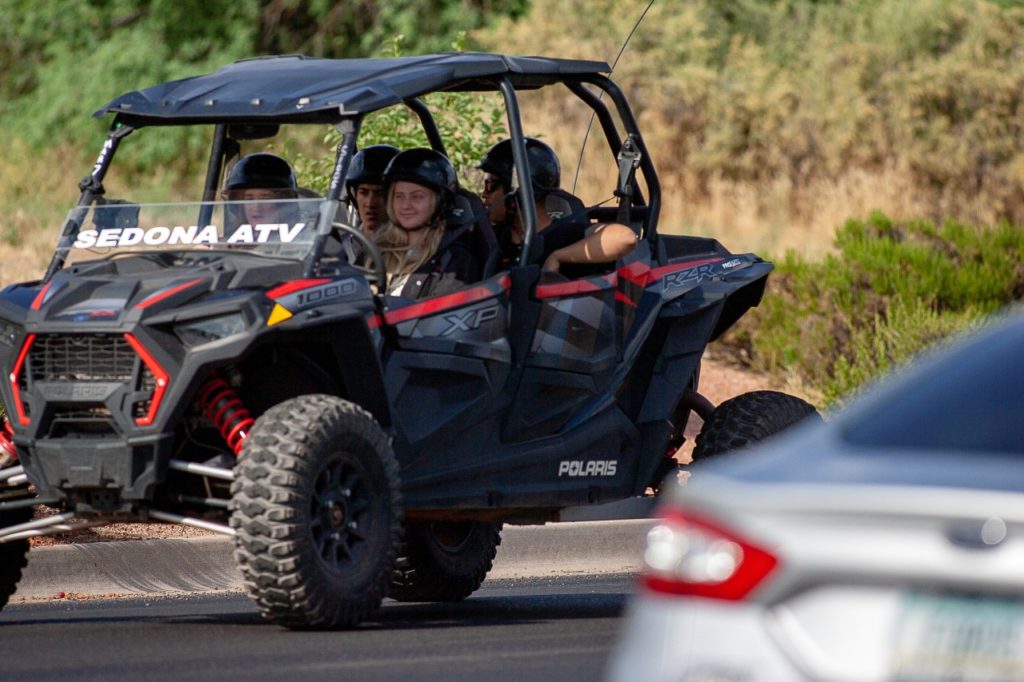
Luedeker said these operations are effective, but the agency is maxed out at about four per year in the 525 area. He said the OHV fund “is spread really thin” around the state.
“I doubt that we’ll ever have the capability of putting a concentrated effort out there more than four times a year, just because it’s difficult to find officers and get them coordinated with the aircraft assist,” he said.
Some OHV fund money is spent on signage to coax drivers away from prohibited areas, but “there is a real tendency for recreation users to just drive past the signs,” Luedeker said.
City of Sedona
Residents of the 525 corridor believe the Bear Mountain area has become ground zero for Sedona’s motorized recreation in part as a biproduct of Sedona’s well-intentioned actions to manage the city’s growing OHV activity, as well as the city’s worsening traffic, which makes OHV routes like Broken Arrow and Schnebly Hill more difficult to access for renters paying by the hour.
Faced with a backup at the “Y” roundabout, renters are encouraged to head west.
Sedona created OHV work groups in 2014 and 2017 in response to resident concerns about noise, safety and environmental impacts. Sedona’s first UTV rental business is believed to have opened in 2006. In 2015 a second opened, and today there are at least five.
One of the accomplishments of the first work group was to assist in winning a $300,000 Arizona State Parks grant that helped fund an OHV coordinator at USFS for three years. In 2017, USFS reduced OHV traffic on Soldier Pass Road by initiating a permit system for private vehicles.
Vice Mayor Scott Jablow thinks the city has maxed out all its options to manage OHVs under current rules.
Jablow said he brought up OHV regulation at the League of Arizona Cities and Towns, but there wasn’t interest from other communities.
“I’m as frustrated as everyone else,” he said. “Until the state wants to change our laws, there’s nothing we can do.”
But Jablow also takes the position that the 525 corridor is outside of Sedona city limits, so he doesn’t consider OHV impacts in that area a city issue. He backed up an email sent to Bindley by former Sedona City Councilman Bill Chisholm before he resigned from the council earlier this year for family reasons.
“The Sedona City Council has zero jurisdiction with regards to your complaint. I certainly empathize with what you are saying, however your course of action involves county and federal resources,” Chisholm wrote.
Yavapai County
Michaels has talked with residents west of Sedona about UTV and RV impacts and appointed two of them, Ross and Bindley, to a Forest Road Land Use committee. She has also helped organize and participates in a working group to discuss the issue.
Asked whether the county could do anything to address motorized recreation impacts, Michaels wrote in an email, “I don’t see this as purely a county issue. Rather, it’s something that cuts across jurisdictions, so it’s going to take lots of help and cooperation to get this solved.
“My hope is, we can craft solutions here that cut across various governments and we solve this to the satisfaction of our constituents and everyone who uses these lands lawfully.”
Congress
Bindley said that O’Halleran’s aide Keith Brekhus has toured the area west of Sedona, seen the dust on the trees, and is participating in the work group video conferences.
O’Halleran’s Office Communications Director Kaitlin Hooker wrote that “our office is working on an appropriations request for more law enforcement for the Forest Service. Rep. O’Halleran and our staff know this is an issue for folks in the area and we are working on it.”




